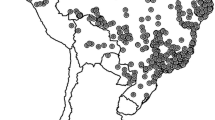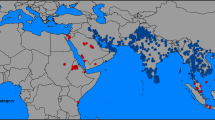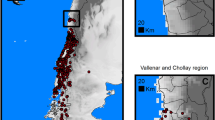Abstract
The small carpenter bee, Ceratina (Neoceratina) dentipes, is an invasive species throughout the South Pacific and has been identified as one of three alien Ceratina species established in Hawaii. Invasive bees are thought to be exacerbating declines of Hawaii’s native yellow-faced bees (Hylaeus) but, outside of the honey bee (Apis mellifera), relatively little empirical work has been done to track the origins and avenues of introduction for these species. Extant research addressing C. dentipes is limited, but suggests that it is a rapidly moving invasive, morphologically similar to both native and non-native bees within its introduced ecosystems, and may be capable of parthenogenic reproduction. Ceratina dentipes thus represents a potentially serious conservational challenge for terrestrial ecosystems throughout the Pacific. Here, we perform the first comprehensive phylogeographic assessment of C. dentipes, drawing from invasive populations across Hawaii and the South Pacific, and from native populations in Southeast Asia. Bayesian phylogenetic reconstruction and analyses of molecular variation both indicate that C. dentipes is very recently introduced in Hawaii. Analyses also reveal that invasive populations of C. dentipes likely originated in Borneo or mainland Southeast Asia before being widely and rapidly dispersed, most likely through anthropogenic transport.



Similar content being viewed by others
References
Aizen MA, Lozada M, Morales CL (2011) Comparative nectar-foraging behaviors and efficiencies of an alien and a native bumble bee. Biol Invasions 13:2901–2909
Albrecht M, Ramis MR, Traveset A (2016) Pollinator-mediated impacts of alien invasive plants on the pollination of native plants: the role of spatial scale and distinct behaviour among pollinator guilds. Biol Invasions 18:1801–1812
Ali H, Alqarni AS, Shebl M, Engel MS (2016) Notes on the nesting biology of the small carpenter bee Ceratina smaragdula (Hymenoptera: Apidae) in northwestern Pakistan. Fla Entomol 99:89–93
Brittain C, Williams N, Kreme C, Klein AM (2012) Synergistic effects of non-Apis bees and honey bees for pollination services. Proc R Soc B 280:1–7
Brown MJF, Paxton RJ (2009) The conservation of bees: a global perspective. Apidologie 40:410–416
Cane JH, Trepedino VJ (2017) Gauging the effect of honey bee pollen collection on native bee communities. Conserv Lett 10:205–210
Cronin AL (2004) A molecular phylogeny and social behaviour of Japanese Ceratina (Hymenoptera, Apidae, Xylocopinae). Insect Syst Evol 35:137–146
da Silva CRB, Groom SVC, Stevens MI, Schwarz MP (2015) Current status of the introduced allodapine bee Braunsapis puangensis (Hymenoptera: Apidae) in Fiji. Aust Entomol 55:43–48
Daly HV (1966) Biological studies on Ceratina dallatorreana, an alien bee in California which reproduces by parthenogenesis (Hymenoptera: Apoidea). Ann Entomol Soc Am 59(6):1138–1154
Daly HV, Magnacca KN (2003) Insects of Hawaii. Vol. 17 Hawaiian Hylaeus (Nesoprosopis) Bees (Hymenoptera: Apoidea). University of Hawaii Press, Honolulu
Darriba D, Taboada GL, Doallo R, Posada D (2012) jModelTest 2: more models, new heuristics and parallel computing. Nat Methods 9:772
Drossart M, Michez D, Vanderplanck M (2017) Invasive plants as potential food resource for native pollinators: a case study with two invasive species and a generalist bumble bee. Sci Rep 7:16242
Drummond AJ, Rambaut A, Shapiro B, Pybus OG (2005) Bayesian coalescent inference of past population dynamics from molecular sequences. Mol Biol Evol 22:1185–1192
Drummond AJ, Suchard MA, Xie D, Rambaut A (2012) Bayesian phylogenetics with BEAUti and the BEAST 1.7. Mol Biol Evol 29:1969–1973
Excoffier L, Lischer HEL (2010) Arlequin suite ver 3.5: a new series of programs to perform population genetics analyses under Linux and Windows. Mol Ecol Res 10:546–567
Friese H (1914) Anhang zur: “Bienenfauna von Java”. Tijdschr Entomol 57:14–61
Graham JR (2015) The nest architecture of Hylaeus anthracinus and other coastal solitary bees. In: Conference paper: 2015 Hawaii conservation conference. https://www.researchgate.net/profile/Jason_Graham5/publication/281040532_The_nest_architecture_of_Hylaeus_anthracinus_and_other_coastal_solitary_bees/links/55d291b408ae7fb244f54093.pdf. Accessed 23 Jan 2018
Graham NR, Gruner DS, Lim JY, Gillespie RG (2017) Island ecology and evolution: challenges in the Anthropocene. Environ Conserv 44:323–335
Groom SVC, Ngo HT, Rehan SM, Skelton P, Stevens MI, Schwarz MP (2014a) Multiple recent introductions of apid bees into Pacific archipelagos signify potentially large consequences for both agriculture and indigenous ecosystems. Biol Invasions 16:2293–2302
Groom SVC, Stevens MI, Schwarz MP (2014b) Parallel responses of bees to Pleistocene climate change in three isolated archipelagos of the southwestern Pacific. Proc R Soc B 281:20133293
Groom SVC, Stevens MI, Ramage T, Schwarz MP (2017) Origins and implications of apid bees (Hymenoptera: Apidae) in French Polynesia. Entomol Sci 20:65–75
Hall TA (1999) Bioedit: a user friendly biological sequence alignment editor and alignment program for Windows 95/98 NT. Nucleic Acid Symp Ser 41:95–98
Hasegawa M, Kishino H, Yano T (1985) Dating of the human-ape splitting by a molecular clock of mitochondrial DNA. J Mol Evol 22:160–174
Hawaii Tourism Authority (2016) Annual visitor research report. http://files.hawaii.gov/dbedt/visitor/visitor-research/2016-annual-visitor.pdf. Accessed 18 Dec 2017
Hebert PDN, Cywinska A, Ball SL, deWaard JR (2003a) Biological identifications through DNA barcodes. Proc R Soc B 270:313–321
Hebert PDN, Ratnasingham S, deWaard JR (2003b) Barcoding animal life: cytochrome c oxidase subunit 1 divergences among closely related species. Proc R Soc B 270:S96–S99
Hirashima Y (1971) Subgeneric classification of the genus Ceratina Latreille of Asia and West Pacific, with comments on the remaining subgenera of the world (Hymenoptera, Apoidea). J Fac Agric Kyushu Univ 16:349–375
Howarth FG (1985) Impacts of alien land arthropods and mollusks on native plants and animals in Hawaii. In: Stone CP, Scott JM (eds) Hawaii’s terrestrial ecosystems: preservation and management. University of Hawaii Press, Honolulu, pp 149–179
Jones JPG, Rasamy JR, Harvey A, Toon A, Oidtmann B, Randrianarison MH, Raminosoa N, Ravoahangimalala OR (2009) The perfect invader: a parthenogenic crayfish poses a new threat to Madagascar's freshwater biodiversity. Biol Invasions 11:1475–1482
Klatt BK, Holzschuh A, Westphal C, Clough Y, Smit I, Pawelzik E, Tschamtke T (2015) Bee pollination improves crop quality, shelf life and commercial value. Proc R Soc B 281:20132440
Klein AM, Vaissière BE, Cane JH, Steffan-Dewenter I, Cunningham SA, Kreme C, Tscharntke T (2007) Importance of pollinators in changing landscapes for world crops. Proc R Soc B 274:303–313
Krombein KV (1951) Additional notes on the bees of the Solomon Islands (Hymenoptera: Apoidea). Proc Hawaii Entomol Soc 14:277–295
Kuhlmann M (2006) Fauna and biogeography of the bees and wasps of the Cook Islands (Hymenoptera Aculeata). J Hymenopt Res 15:26–37
Kumar S, Stecher G, Tamura K (2016) MEGA7: molecular evolutionary genetics analysis version 7.0 for bigger datasets. Mol Biol Evol 33:1870–1874
Lohman DJ, de Bruyn M, Page T, von Rintelen K, Hall R, Ng PKL, Shih HT, Carvalho GR, von Rintelen T (2011) Biogeography of the Indo-Australian archipelago. Ann Rev Ecol Evol Syst 42:205–226
Loope LL, Mueller-Dombois D (1989) Characteristics of invaded islands, with special reference to Hawaii. In: Drake JA, DiCastri F, Groves RH, Kruger FJ, Rejmanek M, Williamson M (eds) Biological invasions: a global perspective. Wiley, New York, pp 257–280
Magnacca KN (2007a) Conservation status of the endemic bees of Hawaii, Hylaeus (Nesoprosopis) (Hymenoptera; Colletidae). Pac Sci 61:173–190
Magnacca KN (2007b) New records of Hylaeus (Nesoprosopis) (Hymenoptera: Colletidae) from O’ahu, Hawai’i. Zootaxa 3065:60–65
Magnacca KN, King CBA (2013) Assessing the presence and distribution of 23 Hawaiian yellow-faced bee species on lands adjacent to military installations on O’ahu and Hawai’i Island. The Hawai’i-Pacific Islands cooperative ecosystems studies unit & Pacific cooperative studies unit. (http://scholarspace.manoa.hawaii.edu/bitstream/handle/10125/34064/v185.pdf). Accessed 18 July 2017
Magnacca KN, Gibbs J, Droege S (2013) Notes on alien and native bees (Hymenoptera: Apoidea) from the Hawaiian Islands. In: Evenhuis NL, Eldredge LG (eds) Records of the Hawaii biological survey for 2012. Bishop Museum Occasional Paper 114, Honolulu, pp 61–65
Michener CD (2007) The bees of the world, 2nd edn. John Hopkins University Press, Baltimore, MD
Moritz RFA, Härtel S, Neumann P (2005) Global invasions of the western honeybee (Apis mellifera) and the consequences for biodiversity. Ecoscience 12:289–301
Okazaki K (1992) Nesting habits of the small carpenter bee, Ceratina dentipes, in Hengchun Peninsula, Southern Taiwan (Hymenoptera: Anthophoridae). J Kans Entomol Soc 65:190–195
Pimentel D, Zuniga R, Morrison D (2004) Update on the environmental and economic costs associated with alien-invasive species in the United States. Ecol Econ 52:273–288
Pleasants JM, Wendel JF (2010) Reproductive and pollination biology of the endemic Hawaiian cotton, Gossypium tomentosum (Malvaceae). Pac Sci 64:45–55
Plentovich S, Hebshi A, Conant S (2009) Detrimental effects of two widespread invasive ant species on weight and survival of colonial nesting seabirds in the Hawaiian Islands. Biol Invasions 11:289–298
Potts SG, Biesmeijer JC, Kremen C, Neumann P, Schweiger O, Kunin WE (2010) Global pollinator declines: trends, impacts and drivers. Trends Ecol Evol 25:345–357
Rambaut A, Suchard MA, Xie D, Drummond AJ (2014) Tracer v 1.6. http://beast.bio.ed.ac.uk/Tracer. Accessed 13 Jan 2016
Reaser JK, Meyerson LA, Cronk Q, Poorter MD, Eldredge LG (2007) Ecological and socioeconomic impacts of invasive alien species in island ecosystems. Environ Conserv 34:98–111
Rehan S, Schwarz M (2015) A few steps forward and no steps back; long-distance dispersal patterns in small carpenter bees suggest major barriers to back-dispersal. J Biogeogr 42:485–494
Rehan SM, Richards MH, Schwarz MP (2009) Evidence of social nesting in the Ceratina of Borneo (Hymenoptera: Apidae). J Kans Entomol Soc 82:194–209
Rehan SM, Chapman TW, Craigie AI, Richards MH, Cooper SJB, Schwarz MP (2010) Molecular phylogeny of the small carpenter bees (Hymenoptera: Apidae: Ceratinini) indicates early and rapid global dispersal. Mol Phylogenet Evol 55:1042–1054
Rehan SM, Tierney SM, Wcislo WT (2015) Evidence for social nesting in Neotropical creatinine bees. Insect Soc 62:465–469
Rejas DH (2008) A preliminary survey of Apoidea (Anthophila) and their use of floral resources on the island of Mo’orea, French Polynesia. Biology and Geomorphology of Tropical Islands, Berkeley Natural History Museum, UC Berkeley Fall, Moorea Class
Roddy KM, Arita-Tsutsumi L (1997) A history of honey bees in the Hawaiian Islands. J Hawai’i Pac Agric 8:59–70
Salzburger W, Ewing GB, VonHaeseler A (2011) The performance of phylogenetic algorithms in estimating haplotype genealogies with migration. Mol Ecol 20:1952–1963
Santos, Aguiar CML, Genini J, Martins CF, Zanella FCV, Mello MAR (2012) Invasive Africanized honeybees change the structure of native pollination networks in Brazil. Biol Invasions 14:2369–2378
Sax DF, Gaines SD (2008) Species invasions and extinction: the future of native biodiversity on islands. Proc Natl Acad Sci USA 104:11490–11497
Sax DF, Stachowicz JJ, Brown JH, Bruno JF, Dawson MN, Gaines SD, Grosberg RK, Hastings A, Holt RD, Mayfield MM, O’Connor MI, Rice WR (2007) Ecological and evolutionary insights from species invasions. Trends Ecol Evol 22:465–471
Shay K, Drake DR, Taylor AD, Sahli HF, Euaparadorn M, Akamine M, Imamura J, Powless D, Aldrich P (2016) Alien insects dominate the plant-pollinator network of a Hawaiian coastal ecosystem. Pac Sci 70:409–429
Shell WS, Rehan SM (2016) Recent and rapid diversification of the small carpenter bees in eastern North America. Biol J Linn Soc 117:633–645
Shell WA, Rehan SM (2017) Range expansion of the small carpenter bee Ceratina smaragdula across the Hawaiian Archipelago with potential ecological implications for native pollinator systems. Pac Sci 71:1–15
Sheppard PJ (2011) Lapita colonization across the near/remote Oceania boundary. Curr Anthropol 52:799–840
Shiokawa M (2009) Taxonomic notes on the dentipes species group of the genus Ceratina in the Oriental region, with a new species and a new subspecies (Hymenoptera, Apidae). Jpn J Syst Entomol 15:319–332
Snelling RR (2003) Bees of the Hawaiian Islands, exclusive of Hylaeus (Nesoprosopis) (Hymenoptera: Apoidea). J Kans Entomol Soc 76:342–356
Soh ZWW, Ngiam RWJ (2013) Flower-visiting bees and wasps in Singapore parks (Insecta: Hymenoptera). Nat Singap 6:153–172
Stachowicz JJ, Tilman D (2005) Species invasions and the relationships between species diversity, community saturation, and ecosystem functioning. In: Sax DF, Satchowicz JJ, Gaines SD (eds) Species invasions: insights into ecology, evolution, and biogeography, 1st edn. Sinauer Associates, Sunderland, MA, pp 41–64
Tabata S (1975) The general circulation of the Pacific Ocean and a brief account of the oceanographic structure of the North Pacific Ocean Part I: circulation and volume transports. Atmosphere 13:133–168
Tadauchi O, Tasen W (2009) Bees of natural forests, teak plantations and agricultural fields in Thailand. Esakia 49:7–13
Tamura K, Battistuzzi FU, Billing-Ross P, Murillo O, Filipski A, Kumar S (2012) Estimating divergence times in large molecular phylogenies. Proc Natl Acad Sci USA 109:19333–19338
Tavaré S (1986) Some probabilistic and statistical problems in the analysis of DNA sequences. In: Miura RM (ed) Lectures on mathematics in the life sciences, vol 17. American Mathematical Society, Providence, RI, pp 57–86
Thompson JD, Higgins DG, Gibons TJ (1994) CLUSTAL W: improving the sensitivity of progressive multiple sequence alignment through sequence weighting, position-specific gap penalties and weight matrix choice. Nucleic Acids Res 22:4673–4680
Traveset A, Richardson DM (2006) Biological invasion as disruptors of plant reproductive mutualisms. Trends Ecol Evol 21:208–216
Traveset A, Richardson DM (2011) Mutualisms: key drivers of invasions … key casualties of invasions. In: Richardson DM (ed) Fifty years of invasion ecology: the legacy of Charles Elton, 1st edn. Blackwell Publishing Ltd., Oxford, pp 143–160
US Fish and Wildlife Service (2016) Endangered and threatened wildlife and plants; endangered status for 49 species from the Hawaiian Islands. Fed Regist 81:67786–67860
van der Vecht J (1952) A preliminary revision of the Oriental species of the genus Ceratina (Hymenoptera, Apidae). Zool Verh 16:1–85
Vanbergen AJ, Espíndola A, Aizen MA (2018) Risks to pollinators and pollination from invasive alien species. Nat Ecol Evol 2:16–25
Westaway KE, Louys J, Awe RD, Morwood MJ, Price GJ et al (2017) An early modern human presence in Sumatra 73000–63000 years ago. Nature 548:322–339
With KA (2002) The landscape ecology of invasive spread. Conserv Biol 16:1192–1203
Acknowledgements
We thank Sam Droege, Quinn McFrederick and Laurence Packer for providing specimens; and Erika Tucker for performing species taxonomic identifications. This work was made possible through funding from the University of New Hampshire and the New Hampshire Agricultural Experiment Station to SMR.
Author information
Authors and Affiliations
Corresponding author
Electronic supplementary material
Below is the link to the electronic supplementary material.
Rights and permissions
About this article
Cite this article
Shell, W.A., Rehan, S.M. Invasive range expansion of the small carpenter bee, Ceratina dentipes (Hymenoptera: Apidae) into Hawaii with implications for native endangered species displacement. Biol Invasions 21, 1155–1166 (2019). https://doi.org/10.1007/s10530-018-1892-z
Received:
Accepted:
Published:
Issue Date:
DOI: https://doi.org/10.1007/s10530-018-1892-z




